5 Major Ports of Ukraine
Ukraine is the second-largest European country positioned in the eastern part of the continent. Once the largest economy in the USSR, it is presently one of those nations in Europe that have a lower-middle-income economy.
In 2021, Ukraine was the largest wheat exporter in the world. Minerals, chemicals and heavy machinery are other significant industries driving economic growth. It was also ranked as the eighth most popular tourist destination in Europe before the Russian invasion of 2022.
Having a diverse topography comprising fertile plains, highlands, lowlands, mountains and navigable rivers, Ukraine is rich in natural resources like lithium, kaolin, natural gas and timber. It has 13 seaports and numerous river ports on the banks of Dnepr, the third largest river in Europe and the Boh River.
However, after the Russian attack on Ukraine, the port operations have been disrupted as a result of Russian blockades and bombings that have killed thousands of citizens. The commercial shipping sector suffers as maritime routes have been cut, major logistics firms have suspended services and Ukrainian ships in the Black Sea and the Azov Sea have been hit by ammunitions.
Port of Odessa and Mariupol are temporarily closed as Russia dominates the Black sea for the time being. Port closures have led to a global hike in oil prices and food inflation. In this article, let us have a look at the 5 major ports of Ukraine.
1. Port of Odessa
The seaport of Odessa is the largest in Ukraine, situated on the Northwestern black sea coastline, at the southwestern end of the Odesskiy Gulf. It is also one of the biggest facilities in the Black sea with an annual cargo capacity of 40 million tonnes, including 21 million tonnes of dry cargo and 25 million tonnes of liquid bulk. Its container terminal is designed to handle more than 900,000 TEU annually. Odessa was the only Ukrainian port that recorded a 2.9% growth in 2021 by handling 671.5 thousand TEU.
In 2000, the Ukrainian government designated a specific territory of the Odessa port as a Special Economic Zone. Spanning 32.5 hectares, this facility has contributed enormously to the development of the port by attracting foreign investment and prominent shipping companies.
Apart from being a busy commercial port, Odessa also serves as Ukraine’s naval base. It houses modern docks and shipyards offering ship repair and construction. The southern harbour of Odessa is lined with fine beaches and popular holiday resorts. The fourth biggest city in Ukraine, Odessa has a diverse economy hinging on numerous industries like chemicals, oil refining, metalworking and food processing.
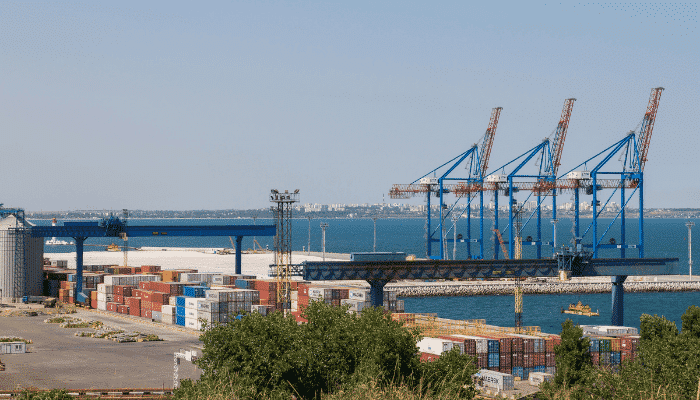
It is fitted with appropriate equipment and facilities for dealing with various cargo types ranging from crude oil, petroleum products, LPG and vegetable oils to all kinds of metals, cast iron and bulk such as sugar, grains, paper bundles, and perishable goods like fruits and miscellaneous general cargo.
Odessa port covers 141 hectares and comprises 54 well-protected berths with depths up to 13 m. It has 8 terminals and 5 harbours namely the Quarantine harbour, New Harbour, Cabotage harbour, Convenience Harbour and Oil Harbour.
The port has a total storage area of 425,070 m2 and a sheltered warehouse space covering 60.45 m2. Around 14,000 TEU can be stored in the container yard and 13,500 tonnes of perishable items are kept in the port’s many refrigerated stations.
The oil terminal of Odessa is the largest in Ukraine with five berths for accommodating oil tankers up to 250 m in length and having a 12 m draft. It has many storage tanks for keeping up to 539,000 m3 of dark petroleum products, 122,000 m3 of light petroleum products and 6,000 m3 of liquefied gas.
Grain Terminal of Odessa port is one of the biggest facilities in the Black sea and the Mediterranean sea basins with a total capacity of 300,000 tonnes. It can also handle some general cargo and bulk. The terminal has an annual grain throughput of 3.5 million tonnes a year and a general cargo capacity of half a million tonnes.
The Transit-Cargo terminal is operational 24-hours a day and has a six-hour turnaround time for containers passing through the port. Covering 5 hectares, it has 2 warehouses with a capacity for over 4000 pallets or packages.
The Passenger Terminal located in the city’s historic province is a world-class facility serving more than four million passengers a year. It also houses a concert hall, a Marine art gallery, a 4-star hotel, a yacht complex, an underwater swimming centre and the famous St Nicholas Church.
2. Port of Chernomorsk
Previously known as Ilyichevsk, Chernomorsk commercial port lies on the southwestern shores of the Black sea. It was built as a headquarters for the Black Sea Navigation Company and houses the manufacturing plants of Antarktica, Ukraine’s biggest fishing enterprise. Over the years, the port city has grown to be one of the richest towns creating abundant employment and attracting people by offering higher incomes. Chernomorsk port is the second biggest port in Ukraine and handled 112.2 thousand TEU in 2021.
It is situated at the crossroads of key transportation routes going all the way from Europe to Asia through the developed regions of Ukraine, Russia and Kazakhstan via the Mediterranean sea, the Atlantic and the Indian Oceans offering great maritime connectivity to 100 major seaports across the globe.
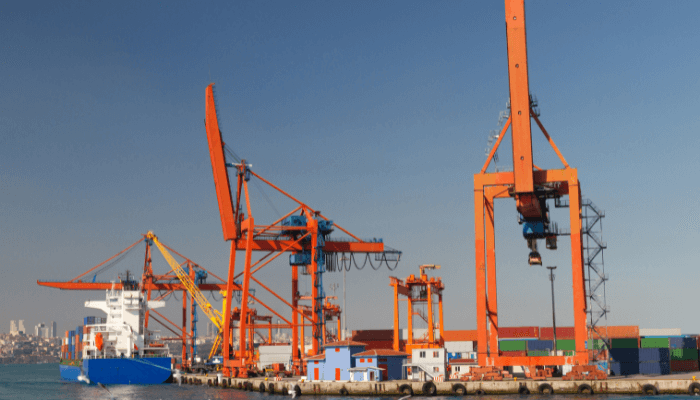
Another vital characteristic of the port is its universality. The specialised port terminals equipped with the latest port equipment, loading machines and gripping devices enable Chernomorsk to handle a wide range of cargoes including general, containers, roro, liquid bulk and breakbulk.
The port has an annual handling capacity of over 32 million tonnes, with a 6000 m berthing line and a total of 129 modern berths. Its expansive storage areas including 580,000 sq m of outdoor storage and 27,000 m2 of warehouse space can conveniently accommodate 1.5 million tonnes of cargo.
Container Terminal
The port’s container handling facility comprises 5 wharves with a total container throughput capacity of 1.15 million TEUs. The container stuffing complex handles rolled metal, slabs, motor vehicles, glass and other equipment. With a storage capacity of 26,000 TEU, it is equipped with 606 reefer connections and an automated terminal operating system.
The Port’s specialised ore complex deals with shipments of non-ferrous ores. It has an annual throughput capacity of 3 million tonnes and a total warehouse capacity of 150,000 tonnes. The Chernomorsk fuel terminal handles diesel fuel, petrol, and heating oil and is endowed with a tank battery having a capacity of 77,000m3 and 6 technological pipelines. Around 2.4 million tonnes of petroleum products pass through this complex.
Grain Terminal
Comprising two berths and 38 silo tanks, this facility handles around 4 million tonnes of grain every year. It can accommodate two Panamax size ships weighing up to 70,000 tonnes each and is equipped with four discharging stations, and storage space for keeping 190,000 tonnes of grain.
Adjacent to the grain terminal is numerous processing plants such as the Oil and Fats industrial complex where vegetable oil for export and tropical oils for import are transferred using pipelines. Its oil station and coastal tanks can store up to 40,000 m3 of sunflower, soya bean and tropical oils. It can handle up to 1 million tonnes of cargo annually.
3. Port of Yuzhny
Yuzhny seaport lies on the northwestern Black sea Coast in the province of Odessa. The port is divided into the northern and southern port harbours which have specialised terminals for handling liquid cargo such as petroleum products, oils, chemicals, ammonia, methanol and dry cargoes comprising metals, ores, coal, grains and much more. Approximately 35,800,000 tonnes of cargo is handled at this facility annually.
Operational throughout the year, Yuzhny port has a 3 kilometre wide and 15 km deep navigation channel that can accommodate ships up to 280 m long and 49 m wide with a maximum draft of 14.5 m. Termed the youngest and deepest port of the country, it has an annual cargo capacity of over 20 million tonnes. It is also an important transhipment hub of the region and is famous for its modern oil terminal. An industrial zone is situated in the port premises that has boosted regional economic growth and created new employment opportunities.
The Transbunker oil terminal comprises 2 wharves covering 600 m for accommodating two very large oil carriers simultaneously. It also has storage facilities for keeping 60,000m3 of fuel and diesel oil. The Pivdenny Oil terminal has a dedicated wharf covering 365 m with a depth of 14 m for handling 30,000 to 100,000 DWT oil tankers. The Fertilisers terminal incorporates two docks for handling bulk urea and ammonia.
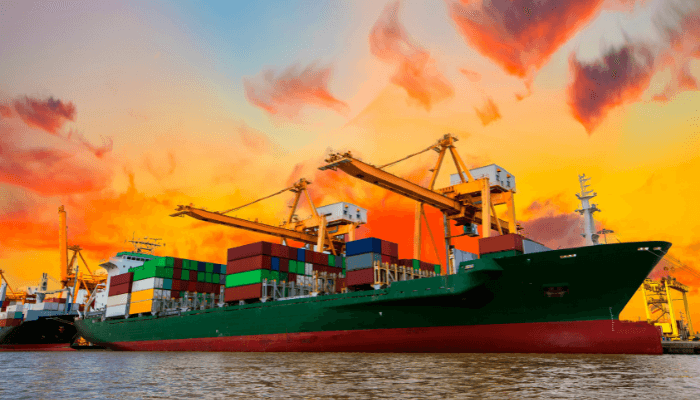
The Chemicals handling facility specialises in dealing with hazardous chemicals, methanol, acetic acid, ammonium nitrate and ammonium sulphate.
The coal terminal incorporates three docks capable of accommodating 278 m long and 48 m wide coal carriers. Grain is handled at the TIS Terminal and steel products at pier number 8, with an average loading rate of 3000 to 7500 metric tonnes per day, depending on the type and size of steel goods.
4. Port of Berdyansk
Berdyansk port is the only maritime transportation hub of the Zaporozhye region and a dynamic facility situated in the northeastern part of Berdyansk Bay on the Azov sea coast. It consists of the outer roadstead, inner road and two, western and eastern harbour basins. Berdyansk handles different kinds of cargo like scrap metal, metal products, ores, coal, chemicals, minerals, grains, refined oil and light oil on its 9 dedicated berths.
It also houses a passenger terminal that receives small boats, ferries and internal cruise liners, a special oil transfer complex, and numerous processing units located in the eastern port area. Operational throughout the year, it has a 1.4 km berthing line, 103,720 m2 of open storage yards and 14,750 m2 of sheltered warehouse space.
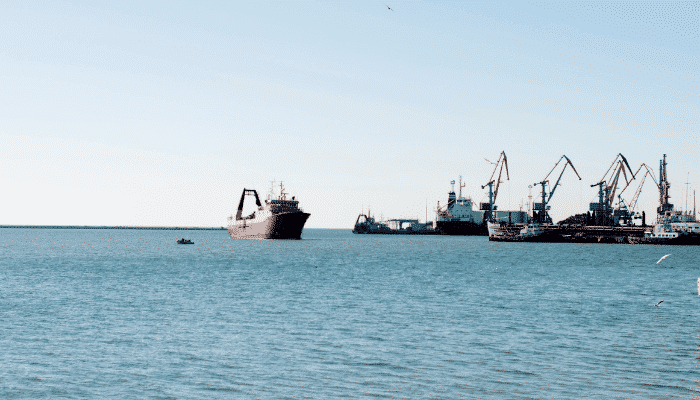
The Petroleum Terminal has a 320 m designated wharf and 3 storage tanks for handling 2500 tonnes of light petroleum products and 4000 tonnes of industrial oils daily. Equipped with 5 pumping facilities the terminal can unload 4 to 8 tankers simultaneously in just three hours. The annual throughput capacity of the terminal totals 800,000 tonnes a year.
The Container Terminal incorporates a 230 m berth with a 9 m quay wall. It has a mechanised container yard for storing 2,200 TEU, 8,600m2 of open storage, a 1400m2 container warehouse and a depository for container stuffing with a capacity of 10,000 tonnes. It is equipped with four gantry cranes and 5 rail-mounted cranes. The terminal can handle 30,000 TEU annually.
The grain Terminal of Berdyansk port is being developed in five phases. Currently, the first phase is completed and comprises a module-type storehouse for keeping 18,000 tonnes of grains and 6 reservoirs with a total capacity of 21,000 tonnes. The southeastern grain terminal handles more than 1.5 million tonnes of grain annually.
5. Port of Mariupol
A sea of Azov port, Mariupol is situated in the northwestern part of Taganrog Bay, at the mouth of the Kalmius river. It counts among the leading Ukrainian ports and is the most developed facility on the Azov sea coastline. It is also known as the Sea Gates of Donbas and consists of an outer and an inner harbour. The latter has a grain terminal, a coal handling facility and a western port. Mariupol can handle coal, metal ores, grains, iron and steel products, equipment, containerised goods, perishable items and other cargo. Approximately 2550 ships, 17,000,000 tonnes of cargo and 10,000 TEU are handled annually.
Lying amidst one of the biggest industrial regions of Ukraine, Mariupol was developed in the second half of the 19th century to serve the southern part of the country. Known as Zhdanov in the 1950s, it was a major coal export facility during Soviet times. It handled a significant amount of Russian cargo however after the Russian Invasion of Ukraine in 2022, Mariupol port has been bombed continuously since the war began on 24th February.

It covers about 74.4 hectares and comprises 18 berths with an overall length of 4.2 km. Mariupol can easily accommodate ships with a length of up to 250 m and a draft of 8 m. This facility has 14,100 m2 of warehouse area and 260,700 m2 of open yards.
The port’s coal terminal handles 5 million tonnes annually and is equipped with 2 railway truck tippers, conveyor lines, 2 stackers and 3 coal loading devices. The Container terminal spans 34,000m2 and has an annual container throughput of 50,000 TEU.
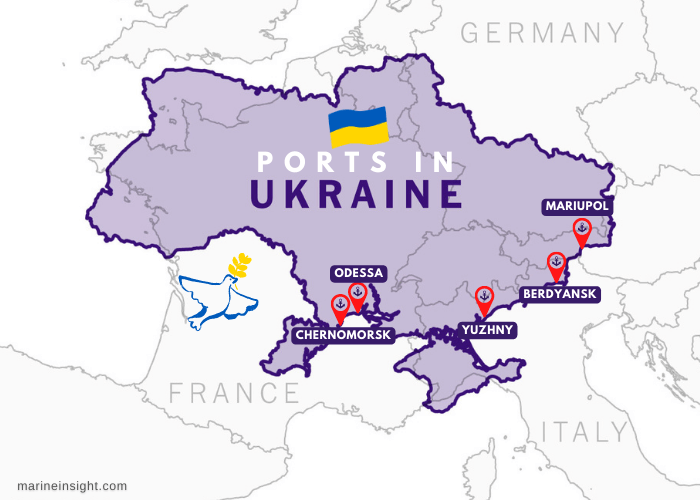
You might also like to read:
- 7 Major Ports in Russia
- 10 Major Ports in Europe
- 6 Major Ports in Turkey
- 8 Major Black Sea Ports
- 10 Azov Sea Facts You Might Not Know
Disclaimer :
The information contained in this website is for general information purposes only. While we endeavour to keep the information up to date and correct, we make no representations or warranties of any kind, express or implied, about the completeness, accuracy, reliability, suitability or availability with respect to the website or the information, products, services, or related graphics contained on the website for any purpose. Any reliance you place on such information is therefore strictly at your own risk.
In no event will we be liable for any loss or damage including without limitation, indirect or consequential loss or damage, or any loss or damage whatsoever arising from loss of data or profits arising out of, or in connection with, the use of this website.
Do you have info to share with us ? Suggest a correction
Disclaimer :
The information contained in this website is for general information purposes only. While we endeavour to keep the information up to date and correct, we make no representations or warranties of any kind, express or implied, about the completeness, accuracy, reliability, suitability or availability with respect to the website or the information, products, services, or related graphics contained on the website for any purpose. Any reliance you place on such information is therefore strictly at your own risk.
In no event will we be liable for any loss or damage including without limitation, indirect or consequential loss or damage, or any loss or damage whatsoever arising from loss of data or profits arising out of, or in connection with, the use of this website.
Latest Maritime Knowledge Articles You Would Like:
Subscribe To Our Newsletters
By subscribing, you agree to our Privacy Policy and may receive occasional deal communications; you can unsubscribe anytime.















